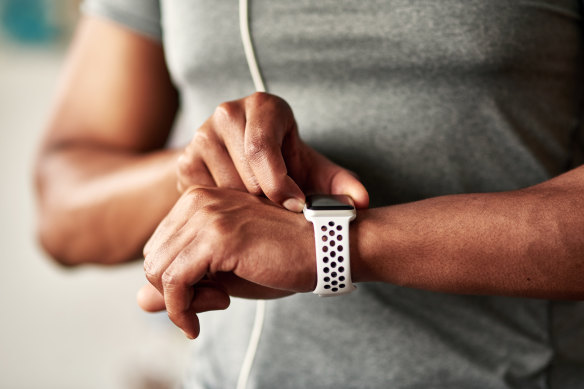This was published 9 months ago
What is heart rate variability? And how much attention should we pay it?
By Sarah Berry
From the moment our heart starts beating in utero to the day we die, a group of cells in the organ’s top-right corner controls the automatic contractions that make it pulse.
The rhythm of those contractions is influenced by the accelerator of our sympathetic nervous system (“fight or flight”) and the brake of our parasympathetic nervous system (“rest and digest”). The interplay between these branches of the autonomic nervous system creates a subtle variation between each beat, referred to as heart rate variability (HRV).

HRV can be tracked on wearable devices, like the Apple Watch.Credit: Getty Images
As technology has made tracking HRV more accessible – close to 40 per cent of Australian adults own a device that can measure it – it has become a favoured metric among elite athletes and those looking to improve their overall health.
Experts say HRV is important and has a key advantage over other health metrics. But it can also be overused, misunderstood and inaccurate.
Why HRV matters
When both the accelerator and brake are functioning well, there is greater variability in the time (measured in milliseconds) between beats. They are closer together as we inhale and further apart as we exhale. So if you look at your resting heart rate of 60 beats per minute, for example, some beats will be one second apart, while others may be more or less.
However, when the sympathetic system is in overdrive – from stress, illness, fatigue, poor fitness or poor sleep, overtraining or alcohol – our breathing becomes more shallow and our heart rate faster, lowering our HRV. “This is because the body is less able to switch between ‘fight or flight’ and ‘rest and recovery’ states smoothly, which is reflected in the reduced variability of the time intervals between heartbeats,” says Dr Matthew Ahmadi, a research fellow at The University of Sydney and National Heart Foundation.
Sympathetic overdrive – when our body’s stress system is unable to remove its foot from the pedal – is bad for mental health but can also negatively affect organ systems.
What is ‘good’ and ‘bad’ HRV?
The average HRV tends to lower with age and lack of fitness, but there are no scientifically validated cutoffs for “good” or “bad”, says clinical associate professor Kegan Moneghetti. In fact, Apple (the most used brand in the market) doesn’t offer classifications for high or low in their Health app. Rather, it views HRV is an individualised, changing metric.

The Baker Institute’s Kegan Moneghetti, nephew of Olympic marathon runner Steve Moneghetti.Credit: Suppplied
Even if a person has a “low” reading according to another algorithm, it’s not bad, says Matty Abel, an athlete and the running coach who has helped train Nedd Brockmann.
“Low HRV can be a good thing – it can show you’re training hard,” he says. “If you’re matching that with good hydration, good nutrition, good sleep and some rest period, you’ll be in a good HRV in the next week. If you’re constantly in the red … you’ll get injured, you’ll get sick, and you’ll have no energy.”
How can HRV data help us?

Athlete and run coach Matty Abel.Credit: Lyndon Marceau
David Scott, associate professor at Deakin University’s School of Exercise and Nutrition Sciences self-confessed data geek, tracks his HRV along with other health metrics.
“A key advantage of HRV is that it provides a dynamic estimate of your health and recovery status throughout the day, compared to other metrics that are quite static and only meaningfully change over long periods of time such as resting heart rate, blood pressure and VO2 max.”
Abel, who coaches athletes with HRV of 100 milliseconds and people with 30 milliseconds, says this “live image” of what is happening within our nervous system makes it an important metric for guiding training intensity and understanding performance.
“It’s not one-size-fits-all, it’s where are you right now,” says Abel, who uses a Whoop band and finds that intense exercise at night and eating before bed affect his scores.
“If someone is really stressed, then less training is probably better, and we need to support your nervous system as much as possible. It might be meditation before sleep, yoga instead of [HIIT], a lighter session or having the day off so you can recharge to perform tomorrow.”
Moneghetti, who uses an Apple Watch, adds that there is also a lot of interest in HRV among researchers.
He is currently using the metric in a clinical trial of people with chronic fatigue syndrome to see if their HRV changes after bouts of exercise – when they typically experience worse symptoms.
“HRV could be a marker of this disease in a population that has previously been stigmatised because we don’t have a clear test.”
He and colleagues at Melbourne’s Baker Institute are also running a trial to see if HRV might influence the way they deliver exercise programs to cardiac rehabilitation patients. And its potential is not just treating those with physical illnesses.
A study from earlier this year suggested HRV could help identify the optimal treatment for people with post-traumatic stress disorder. Specifically, those with low HRV may benefit more from practices like yoga, whereas those with higher HRV seemed to benefit more from trauma-focused psychological therapy.
“For trauma patients in a dissociative or ‘freeze’ state, self-reported emotional regulation may be limited, making HRV an even more important metric,” adds Jessica Maguire, a former physiotherapist and author of the Nervous System Reset.
Risks of overuse and abuse
Despite its great potential, it can also be “overused and abused”, says Ahmadi.
“Elite athletes use HRV as one of many tools to inform their training and recovery strategies, often guided by professionals who can interpret the data in the context of an overall training program,” he says. “In contrast, amateur athletes might fixate on HRV, using it in isolation or may draw conclusions from day-to-day fluctuations without considering other factors.”
And because HRV is not yet a validated or TGA-approved calculation, there can be data inaccuracies or inconsistencies in some consumer-grade wearables.
Provided we understand the limitations and focus on the trends rather than day-to-day fluctuations, Moneghetti believes it is a “very good” metric to track over time.
Make the most of your health, relationships, fitness and nutrition with our Live Well newsletter. Get it in your inbox every Monday.